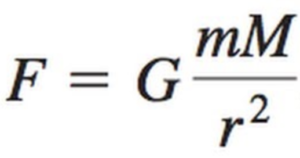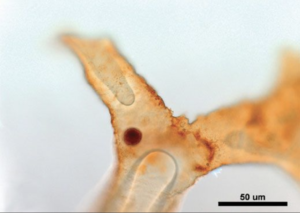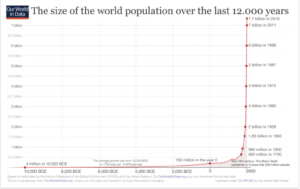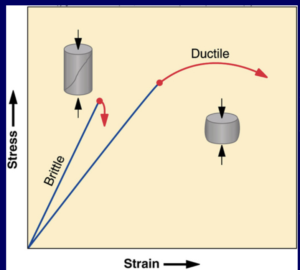Tucked away in the very depths of the AIG website, I found a shocking page titled “Six Evidences of a Young Earth.” I decided to go through each one below and explain how it is an example of bad science while offering a rebuttal to it using valid scientific evidence.
Before we begin, it should be explained that AIG believes the Earth to be around 6,000 years old- a number they arrived at by tracing the Biblical history. I hope as you read, you can see how they accept all “data” that supports this and disregard glaring evidence of any confounding findings.
“Evidence” 1: Radiocarbon in Diamonds
Very eager to attack the validity of radioactive dating methods, AIG questions radiocarbon dating. C-14 has a half life of only 5,730 years and is only used to date organic material less than 50,000 years old because it doesn’t last in material for long relatively speaking. However, AIG claims that scientists have found diamonds projected to be over 50,000 years old with C-14. Therefore, AIG proposes this is proof that C-14 dating techniques are wrong and the earth cannot be that old. It then sites a paper by Dr. A Snelling as proof.
In examining this paper, I immediately noticed bad science. First and foremost, of course C-14 can still exist in materials older than 50,000 years! Scientists only use C-14 dating for organic material up to 50,000 years old because the amount of C-14 remaining in materials older than that is so small that false readings can be made. Anyone who argues otherwise doesn’t understand the idea of a half-life. In the paper, Dr. Snelling dates one diamond to 55,000 years ago, 9 diamonds from the University of California to 64,900-80,000 years old, and Precambrian graphite sample at 58,400-70,100 (remember the Precambrian era is known to be 4.6 MYA). They thus conclude this shows a much younger earth. However, according to the paper, the samples only demonstrated C-14 amounts of 0.01-0.07pMC and 0.03-0.031 pMC. The reason, then, that the dating method provided dates as young as those included above is because this is exactly what happens when you try to use C-14 methods with C-14 amounts as little as this. C-14 dating is extremely inaccurate when C-14 levels are low, which is exactly why scientists only use it dating 50,000 years and less. This paper is an example of erroneous science, and the AIG claim is therefore baseless.
I’ll leave you with this: Let’s say AIG is right and that the results of this paper are correct. The diamonds are aged at around 65,000 years ago even though they are supposed to be Precambrian. Still, on their home page, they conclude that the Earth is 6,000 years old exactly as “proved” by biblical genealogy. Therefore, it seems in trying to refute scientific practices, they have literally contradicted their main argument.
“Evidence” 2: Recession of the Moon
This was an interesting one to analyze… AIG acknowledges that the gravitational pull of the moon causes a tidal bulge on the Earth that results in the moon spiraling outwards away from the Earth very slowly. However, they begin extrapolating erroneously. Their logic is that the moon should have been closer to the Earth in the past, and based on the current rate of recession, we can calculate how much the moon has moved over time. It then claims that if the Earth was over 1.2 billion years old like scientists think, the moon would have been touching the Earth- a “major dilemma”! I would first like to point out that immediately, AIG is committing another hypocritical claim. In their argument against radioactive dating (see my post Age of the Earth), one of their biggest points is that we cannot use science to try to estimate conditions at the beginning of the Earth’s conception as we were not there to directly observe them. Word for word, AIG claimed “what we observe and measure today exists only in the present.” Therefore, it seems rather ironic that now they attempt to use mathematical models to calculate the distance the moon has moved over time to strengthen their argument. This is a perfect instance of only using data when it supports your hypothesis- a poster-child example of bad science!
Nevertheless, let’s look at their argument. AIG makes a dangerous claim when they assume that the rate of the moon recession is constant. First of all, the equation for the gravitational force between two objects is shown below where F is the force of gravity, G is the gravitational constant, m and M are two different masses, and r is the distance between m and M:

Any competent individual who can work with equations only needs a quick glance at this to understand the force between two objects is stronger as the distance between them, r, decreases. AIG doesn’t explain how they arrive at their estimate, but they do say “based on the current rate of recession, we can calculate how much the moon has moved over time.” With this word choice, it seems as though they erroneously extrapolated using the current rate of recession.
Regardless, it turns out there is paleontological evidence that the rate of recession has changed vastly over time. This data can demonstrate the periodicity of the tides through observing tidal rhythmites or patterns in sediment that help determine tidal frequencies in the past. By analyzing these patterns, it has been determined that the lunar retreat was around 1.95 cm/year 650 million years ago, and 1.27 cm/year around 2.5 billion years ago. Therefore, the slowing rate of recession and models predict that an old earth can coexist with the current rate of recession we see in the moon. One does not contradict the other. The tidal rhyhmites known to be millions of years old could not even have formed without tides caused by the moon. Further, the idea of a slower recession of the moon when the moon was closer to the earth millions of years ago directly correlates with the equation I provided as the force between the two masses (earth and the moon) would have been greater at a shorter distance, r, causing slower rate of moon recession away from the earth.
“Evidence” 3: Earth’s Decaying Magnetic Field
AIG argues that the Earth has a changing magnetic field that is constantly weakening as time progresses. Getting their ideas from Dr. Thomas G Barnes and using his work to support their ideas, AIG claims that each century, the magnetic field becomes 5% weaker. Thus, if the Earth was 6,000 years old, at this time the magnetic field strength would be stronger but still life-sustaining. In contrast, if the earth were many millions of years old, the magnetic field would be too strong to sustain life. Once again, AIG falls victim to contradicting themselves by using models to predict the past and at the same time saying we cannot do that. Yet again, they erroneously extrapolate, not taking into account changing conditions throughout Earth’s time.
Nevertheless, it is well-known in the scientific community that the earth has shifted polarity several times throughout its existence. In fact, paleomagnetism provides evidence of this. By determining the paramagnetism of rocks, scientists can observe and record ancient magnetic reversals which has developed into the Geomagnetic Polarity Time Scale (GPTS). Furthermore, studies like Barnes’ are completely flawed. Barnes took 25 measurements of magnetic field strength and fit them to an exponential curve, concluding that the earth must be younger than 20,000 years old. He and AIG completely disregard the fact that the earth’s polarity has shifted and instead believes erroneously that the magnetic decay can be explained exponentially. From the field of paleomagnetism, there is solid data that proves otherwise, and the methods are much more reliable than simply taking 25 data points and extrapolating based on an exponential curve.
“Evidence” 4: Dinosaur Soft Tissue
AIG claims that there have been many examples of preserved biological materials in supposedly ancient rocks and fossils. For instance, a fossilized T. rex femur with flexible connective tissue, branching blood vessels, and intact cells has recently been found. This would not make sense, according to them, if the dinosaur tissues were 65 million years old like scientists think.
The discovery that AIG is referring to was one conducted by Mary Schweitzer, an American paleontologist at North Carolina State University. When analyzing Dinosaur fossils from Montana, she discovered collagen, red blood cells, and other cells inside of the bones. It is interesting to note that Dr. Schweitzer is herself a devout Christian but does not believe that this provides evidence against evolution and still believes that the dinosaur is over 65 million years old. As she says in her interview, she gets angry when AIG and other creationist organizations “hijack” her findings and twist her data around to fit their own. She makes the point that these organizations do not offer their own data and simply alter and interpret the hard work of scientists like her. She believes that there is much more the scientific community can learn about fossilization processes. It is known that soft tissue can survive for millions of years in the exact right conditions. In fact, she points out that after removing the bones from their original environment where they were preserved, the soft tissue quickly decays. Most bone remains in museums and exposed to the air do not have any soft tissue. Therefore, she believes it is possible for soft tissue to be preserved like that for millions of years in perfect conditions. As we know, fossilization is a rare process, and certain conditions have to be met perfectly. Perhaps, there is more to learn about the fossilization process and preservation. Yet, this does not provide evidence for a young Earth.

Red Blood Cell from Dr. Schweitzer’s sample as shown by Smithsonian Magazine
“Evidence” 5: Human Population Growth
Anthropologists, please skip this one- it might frustrate you a little too much. For their fifth piece of evidence for a young earth, AIG exclaims with the enthusiasm of a young child discovering 2+2, “It’s amazing what basic mathematics can show us about the age of the earth!” They then go on to explain that we can calculate the years of human existence by understanding that the population doubles every 150 years to get an estimate of the world’s population at a given time. It then says 6,000 years would give an answer consistent with this mathematical model whereas if the human species was 50,000 years old (much younger than what is accepted scientifically), then the number of people alive today would be 10 to the 99th power.
I’m not sure where to even begin refuting this one. I try to not be biased in my answers, but at this point it just seems as though they’ve given up and are using the worst possible examples to make a mockery of this whole argument. Without even going into science, any person educated in history can tell you that the population growth rate of mankind is not by any means constant. In fact, according to the Population Reference Bureau, a private organization supported by the US Government and the United Nations, humans evolved around 3 million years ago. Further, the vast majority of our existence was as hunter gatherers with a total world population below 10 million. As agriculture developed, population expanded, and there were around 300 million in the year 1 AD. This represents a total growth rate of 0.00006%. Now, if we look at the effects of the Industrial Revolution in the 19th and 20th centuries, there was a clear boom in population as an increase in infrastructure, urbanization, and food surplus allowed for greater populations. In the 20th century alone, the world population increased from 1.6 billion to 6.1 billion people which represents a growth rate of 3.81% per year. Obviously, the rate of human population growth has been affected by our ability to utilize technology and change the way we use our resources and inhabit the planet. Thus, the constant doubling of population growth every 150 years is completely incorrect- take a look at the graph below.

As you can see, for the majority of our existence, the population has been rather stagnate and low. It is not until much more recently that our population has significantly increased. This completely discounts the “basic mathematics” that AIG claims to use to prove a young earth. Common sense and history can refute this bad science.
“Evidence” 6: Tightly-folded Rock Strata
Finally, AIG presents their final piece of “evidence” for a young earth. AIG claims that when rock is bent, it usually cracks and breaks. Rocks can only bend without fracturing when subjected to extreme heat or if they are soft and malleable due to moisture, yet there are numerous places around the world, including the Grand Canyon, where we see evidence of rock folding without evidence of the sediments being heated. AIG claims this is a major problem for geologists who believe that these layers were laid down gradually over long periods of time. Yet it apparently makes sense when we consider these rock layers were formed during Noah’s Flood as described in Genesis. The wet conditions would explain how sedimentary rock can be folded as so.
It seems as though their main argument here is that the folding of sedimentary rock in such a way without a source of heat proves that there was a recent flood (cue Noah’s ark). However, even if this argument was true , this doesn’t prove by any means that the world is only 6,000 years old. The main problem with this argument is that AIG has left out other factors that can cause what scientists call “plastic deformation capabilities” in rocks. AIG only recognizes heat and moisture. In fact, pressure and time are huge contributing factors to deformation of rocks that AIG simply leaves out. It is known that incredible pressure (caused by the building up of rock layer upon rock layer over time) built up over time causes rocks to be deformed, causing what we notice as the folds in sedimentary rock. Scientists call strain the physical deformation that we observe, and stress is the force per unit area a rock receives.


The picture on the left is a schematic diagram of the shearing forces between rock layers in which layers of differential pressure cause altered shapes with respect to one another, creating the folding AIG is referring to. This doesn’t have anything to do with water or moisture and happens simply due to immense pressure over time. The graph on the right demonstrates how as the stress a rock experiences increases, the strain increases to a point. At lower depths of rock layers where pressure is higher, ductile deformation occurs, resulting in the folding of sedimentary layers observed. In this case, AIG leaves out other factors that can affect rock strata formation and deformations. The blatant disregard for other information and data demonstrates bad science as they attempt to provide their own explanation with obvious lack of information.